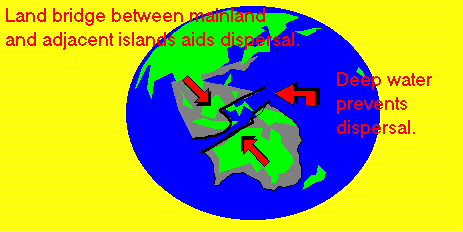Habitat occupationThe effectiveness of an organism to occupy a habitat depends in
part on its means of transportation. Animals must use their own locomotion, while plants
disperse by wind, running water, ocean currents, and animals. Thus, climate and
topographic barriers are more of an impediment to animals than plants. For either,
continental drift poses a significant barrier to diffusion. The separation of continents
has isolated plants and animals in the past thus preventing their complete occupation of a
suitable habitat. Continental collisions have opened land bridges for habitat occupation.
Sea level changes have similarly affected plant and animal distributions. Lowered sea
level, as what occurred during the last ice ages, resulted in chains of islands being
connected opening migration routes for animal and plant species. Sea level rise during
post-glacial times isolated habitats. Isolation thus prevented plant and animal migration.
Presently, trends in global warming are affecting the
distribution of parasites carrying infectious diseases. In a
June 2002 All Things Considered report it was
noted that malaria-bearing mosquitoes from lower elevations are
invading mountain ecosystems at higher elevations as
temperatures rise, affecting Hawaiian bird populations.
Sometimes humans aid in the dispersal of plants and animals. Humans have
intentionally or unintentionally introduced species into habitats that they would
otherwise not have been able to on their own, sometimes with disastrous effects. The
inadvertent introduction of the African Honey Bee in South America is a notable example.
Imported to spur production of honey by mating with other native species, this aggressive
bee was accidentally released. With few natural predators, populations exploded and has
migrated to the southern United States. People have been attacked by swarms of these
"killer bees" when disturbing them. Hawaii's biota evolved in relative isolation. But
after its discovery by white culture, the inadvertent, and the sometimes purposeful introduction of alien plant and
animal species, have endangered Hawaii's native organisms.
All Things Considered
(NPR) segment from March 21, 2000 "Hawaii
Extinction" reports on how Hawaii's geographical isolation makes
its native organisms especially vulnerable to extinction by alien
plant and animal introductions. Human activities have profound effects on habitats. To find out more continue "Digging Deeper: Habitat Degradation and Human Activity" or move on to the next topic by clicking "Continue" below. |

